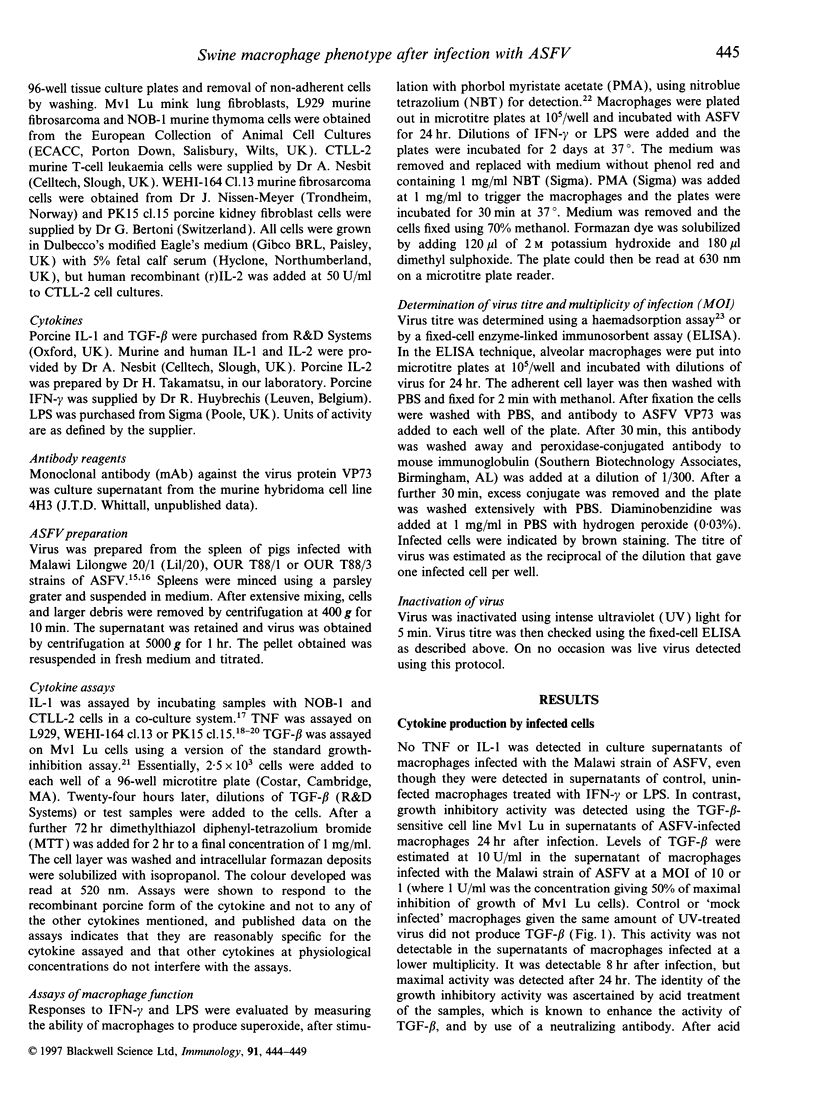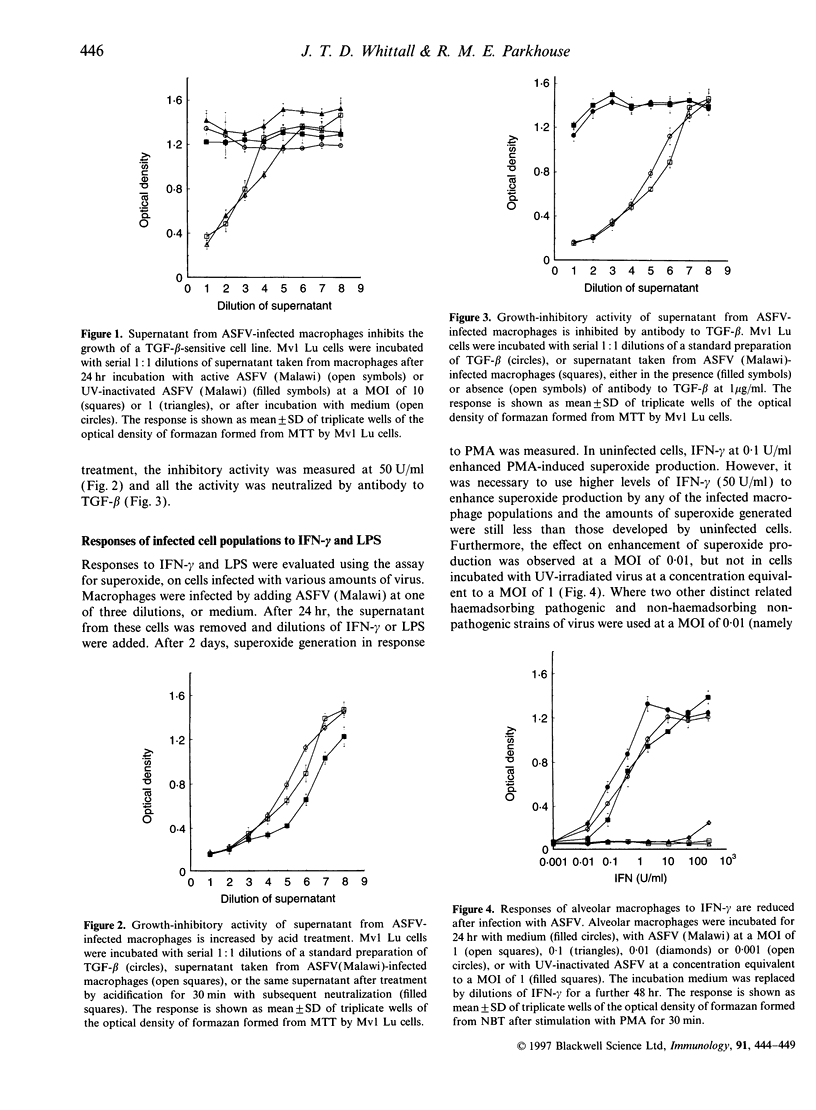Abstract
Cytokines produced by cells of the immune system, including macrophages, can influence inflammatory responses to viral infection. This has been exploited by viruses, which have developed strategies to direct the immune response towards ineffective responses. African swine fever virus (ASFV) is a double-stranded DNA virus that infects macrophages of domestic swine. In this study, primary cells of monocyte macrophage lineage were obtained from the lungs, peritoneum or blood of domestic swine and, after infection with ASFV, supernatants were tested for cytokines using biological assays. The cytokine transforming growth factor-beta (TGF-beta) was detected after infection of macrophage preparations, but tumour necrosis factor (TNF) and interleukin-1 (IL-1) were not detected. ASFV-infected and uninfected macrophage populations were also tested to assess their ability to respond to cytokines by enhancing production of superoxide in the respiratory burst mechanism. Responses to interferon-gamma (IFN-gamma) and lipopolysaccharide (LPS) were suppressed in macrophage populations infected with virus, even at low multiplicities of infection. Addition of TGF-beta to uninfected macrophages resulted in a similar suppression of response, but antibody to TGF-beta did not prevent suppression induced by virus. These results are discussed in relation to the pathology of African swine fever.
Full text
PDF





Selected References
These references are in PubMed. This may not be the complete list of references from this article.
- Ahuja S. K., Gao J. L., Murphy P. M. Chemokine receptors and molecular mimicry. Immunol Today. 1994 Jun;15(6):281–287. doi: 10.1016/0167-5699(94)90008-6. [DOI] [PubMed] [Google Scholar]
- Alcamí A., Smith G. L. Cytokine receptors encoded by poxviruses: a lesson in cytokine biology. Immunol Today. 1995 Oct;16(10):474–478. doi: 10.1016/0167-5699(95)80030-1. [DOI] [PubMed] [Google Scholar]
- Arala-Chaves M. P., Ribeiro A. dos S., Vilanova M., Porto M. T., Santarem M. G., Lima M. Correlation between B-cell mitogenicity and immunosuppressor effects of a protein released by porcine monocytes infected with African swine fever virus. Am J Vet Res. 1988 Nov;49(11):1955–1961. [PubMed] [Google Scholar]
- Bertoni G., Kuhnert P., Peterhans E., Pauli U. Improved bioassay for the detection of porcine tumor necrosis factor using a homologous cell line: PK(15). J Immunol Methods. 1993 Apr 2;160(2):267–271. doi: 10.1016/0022-1759(93)90187-c. [DOI] [PubMed] [Google Scholar]
- Bogdan C., Vodovotz Y., Nathan C. Macrophage deactivation by interleukin 10. J Exp Med. 1991 Dec 1;174(6):1549–1555. doi: 10.1084/jem.174.6.1549. [DOI] [PMC free article] [PubMed] [Google Scholar]
- Cao J. X., Gershon P. D., Black D. N. Sequence analysis of HindIII Q2 fragment of capripoxvirus reveals a putative gene encoding a G-protein-coupled chemokine receptor homologue. Virology. 1995 May 10;209(1):207–212. doi: 10.1006/viro.1995.1244. [DOI] [PubMed] [Google Scholar]
- Espevik T., Figari I. S., Ranges G. E., Palladino M. A., Jr Transforming growth factor-beta 1 (TGF-beta 1) and recombinant human tumor necrosis factor-alpha reciprocally regulate the generation of lymphokine-activated killer cell activity. Comparison between natural porcine platelet-derived TGF-beta 1 and TGF-beta 2, and recombinant human TGF-beta 1. J Immunol. 1988 Apr 1;140(7):2312–2316. [PubMed] [Google Scholar]
- Espevik T., Nissen-Meyer J. A highly sensitive cell line, WEHI 164 clone 13, for measuring cytotoxic factor/tumor necrosis factor from human monocytes. J Immunol Methods. 1986 Dec 4;95(1):99–105. doi: 10.1016/0022-1759(86)90322-4. [DOI] [PubMed] [Google Scholar]
- Flick D. A., Gifford G. E. Comparison of in vitro cell cytotoxic assays for tumor necrosis factor. J Immunol Methods. 1984 Mar 30;68(1-2):167–175. doi: 10.1016/0022-1759(84)90147-9. [DOI] [PubMed] [Google Scholar]
- Fontana A., Constam D. B., Frei K., Malipiero U., Pfister H. W. Modulation of the immune response by transforming growth factor beta. Int Arch Allergy Immunol. 1992;99(1):1–7. doi: 10.1159/000236328. [DOI] [PubMed] [Google Scholar]
- Haak-Frendscho M., Wynn T. A., Czuprynski C. J., Paulnock D. Transforming growth factor-beta 1 inhibits activation of macrophage cell line RAW 264.7 for cell killing. Clin Exp Immunol. 1990 Nov;82(2):404–410. doi: 10.1111/j.1365-2249.1990.tb05461.x. [DOI] [PMC free article] [PubMed] [Google Scholar]
- Haresnape J. M., Wilkinson P. J., Mellor P. S. Isolation of African swine fever virus from ticks of the Ornithodoros moubata complex (Ixodoidea: Argasidae) collected within the African swine fever enzootic area of Malawi. Epidemiol Infect. 1988 Aug;101(1):173–185. doi: 10.1017/s0950268800029332. [DOI] [PMC free article] [PubMed] [Google Scholar]
- Knudsen R. C., Genovesi E. V. In vivo and in vitro effects of moderately virulent African swine fever virus on mitogenesis of pig lymphocytes. Vet Immunol Immunopathol. 1987 Jul;15(4):323–336. doi: 10.1016/0165-2427(87)90004-3. [DOI] [PubMed] [Google Scholar]
- MALMQUIST W. A., HAY D. Hemadsorption and cytopathic effect produced by African Swine Fever virus in swine bone marrow and buffy coat cultures. Am J Vet Res. 1960 Jan;21:104–108. [PubMed] [Google Scholar]
- Martins C. L., Scholl T., Mebus C. A., Fisch H., Lawman M. J. Modulation of porcine peripheral blood-derived macrophage functions by in vitro infection with African swine fever virus (ASFV) isolates of different virulence. Viral Immunol. 1987;1(3):177–190. doi: 10.1089/vim.1987.1.177. [DOI] [PubMed] [Google Scholar]
- Mebus C. A. African swine fever. Adv Virus Res. 1988;35:251–269. doi: 10.1016/s0065-3527(08)60714-9. [DOI] [PubMed] [Google Scholar]
- Mendoza C., Videgain S. P., Alonso F. Inhibition of natural killer activity in porcine mononuclear cells by African swine fever virus. Res Vet Sci. 1991 Nov;51(3):317–321. doi: 10.1016/0034-5288(91)90084-2. [DOI] [PubMed] [Google Scholar]
- Paez E., Garcia F., Gil Fernandez C. Interferon cures cells lytically and persistently infected with African swine fever virus in vitro. Arch Virol. 1990;112(1-2):115–127. doi: 10.1007/BF01348989. [DOI] [PubMed] [Google Scholar]
- Pan I. C., Hess W. R. Diversity of African swine fever virus. Am J Vet Res. 1985 Feb;46(2):314–320. [PubMed] [Google Scholar]
- Powell P. P., Dixon L. K., Parkhouse R. M. An IkappaB homolog encoded by African swine fever virus provides a novel mechanism for downregulation of proinflammatory cytokine responses in host macrophages. J Virol. 1996 Dec;70(12):8527–8533. doi: 10.1128/jvi.70.12.8527-8533.1996. [DOI] [PMC free article] [PubMed] [Google Scholar]
- Sanchez-Vizcaino J. M., Slauson D. O., Ruiz-Gonzalvo F., Valero F. Lymphocyte function and cell-mediated immunity in pigs with experimentally induced African swine fever. Am J Vet Res. 1981 Aug;42(8):1335–1341. [PubMed] [Google Scholar]
- Simon P. L., Laydon J. T., Lee J. C. A modified assay for interleukin-1 (IL-1). J Immunol Methods. 1985 Nov 28;84(1-2):85–94. doi: 10.1016/0022-1759(85)90417-x. [DOI] [PubMed] [Google Scholar]
- Sosroseno W., Herminajeng E. The immunoregulatory roles of transforming growth factor beta. Br J Biomed Sci. 1995 Jun;52(2):142–148. [PubMed] [Google Scholar]
- Spriggs M. K. Cytokine and cytokine receptor genes 'captured' by viruses. Curr Opin Immunol. 1994 Aug;6(4):526–529. doi: 10.1016/0952-7915(94)90136-8. [DOI] [PubMed] [Google Scholar]
- Spriggs M. K., Hruby D. E., Maliszewski C. R., Pickup D. J., Sims J. E., Buller R. M., VanSlyke J. Vaccinia and cowpox viruses encode a novel secreted interleukin-1-binding protein. Cell. 1992 Oct 2;71(1):145–152. doi: 10.1016/0092-8674(92)90273-f. [DOI] [PubMed] [Google Scholar]
- Symons J. A., Alcamí A., Smith G. L. Vaccinia virus encodes a soluble type I interferon receptor of novel structure and broad species specificity. Cell. 1995 May 19;81(4):551–560. doi: 10.1016/0092-8674(95)90076-4. [DOI] [PubMed] [Google Scholar]
- Vieth M., Will A., Schröppel K., Röllinghoff M., Gessner A. Interleukin-10 inhibits antimicrobial activity against Leishmania major in murine macrophages. Scand J Immunol. 1994 Oct;40(4):403–409. doi: 10.1111/j.1365-3083.1994.tb03481.x. [DOI] [PubMed] [Google Scholar]
- Wardley R. C. Effect of African swine fever on lymphocyte mitogenesis. Immunology. 1982 May;46(1):215–220. [PMC free article] [PubMed] [Google Scholar]
- Wilkinson P. J., Wardley R. C., Williams S. M. African swine fever virus (Malta/78) in pigs. J Comp Pathol. 1981 Apr;91(2):277–284. doi: 10.1016/0021-9975(81)90033-5. [DOI] [PubMed] [Google Scholar]
- Wold W. S., Hermiston T. W., Tollefson A. E. Adenovirus proteins that subvert host defenses. Trends Microbiol. 1994 Nov;2(11):437–443. doi: 10.1016/0966-842x(94)90801-x. [DOI] [PubMed] [Google Scholar]


